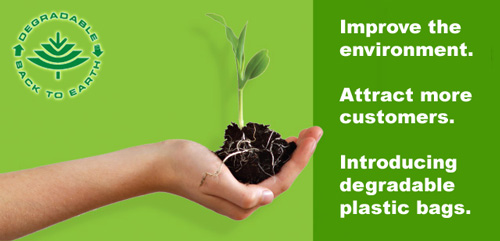

 |

|
Degradable Products | |

What is Degradable? There are a number of words used to describe different systems for degrading plastics: Degradable, Totally Degradable and Oxo-biodegradable All these terms refer to the same system and include technologies which are similar. The common feature of these is that the progress of the primary degradation depends on any combination of light, heat, stress and air. Biodegradable, Hydro-biodegradable These terms are also the same as one another and refer to technologies where the degradation depends on the plastics being in a biologically active environment - for example, in compost - and where the destruction of the material is a result of its consumption by microbes. From this description it can be seen that Degradable plastics will disappear in all the same locations as Biodegradable plastics. The reverse, however, is not the case as Biodegradable plastics will not degrade unless, for example, they are buried. How does it Work? The degradation process is initiated at the time the polyethylene or polypropylene is extruded by the inclusion of a small amount of a special additive. This additive works to break down the carbon-carbon bonds in the plastic leading to a lowering of the molecular weight and eventually to a loss of strength and other properties. Stabilizers work to ensure that a sufficiently long useful life is provided for each specific application. For example, a garbage bag might require a useful life of say 18 months before beginning to lose its strength whereas a bread bag might only require a few weeks. Significantly, the Additive range does not need a biologically active environment to start degrading - this will happen even if the plastic is left in the open air! This is very important if we are to address the serious litter problems caused by waste plastic. For this reason in particular, our 'totally degradable' plastic is superior to 'bio-degradable' which requires the plastic to be in a biologically active environment (for example, by being buried in the ground) before. Frequently Asked Questions 
With what level of certainty can the timing of degradation be controlled? As indicated elsewhere, the speed of degradability can largely be controlled by the additive package used for any particular application. The actual speed of degradation, however, is affected by the levels of uncontrollable variables - particularly heat, light and stress - to which the plastic is exposed. Higher than planned levels of these will speed up the process and lower levels will slow it down (but not stop it). For this reason, manufacturers typically build a significant safety margin into the planned degradation time so as to ensure that the properties of the plastic remain intact for the full useful life of the product in question.
Do the additives or finished products need to be stored or handled in any special way? As indicated in the answer above, a degree of care is sensible so as to ensure that the products are not exposed to excessive heat, light or stress. For example, degradable plastics should be stored in a cool/shaded place rather than in the open air or in a hot, sunny place. Beyond this sort of 'common sense', no special requirements apply.
Is biodegradation the end result of degradation? For Degradable film, the answer is yes. Oxidative degradation of Degradable polyethylene and polypropylene causes a breakdown of the molecular backbone of these plastics. The molecular chains become shorter and water 'wettable' permitting the formation of a bio-film on the surface of the plastics which allows microbial deterioration to take over
Flexible plastic packaging, by its nature, has properties that are essential to provide effective packaging products. These properties include water resistance, flexibility and strength. The long entangled molecular chains within a polymer determine these properties. With the oxidative action of our Degradable Additive the molecular 'backbone' collapses. The initial result is embrittlement and disintegration - the material can no longer be considered as a plastic. Ultimately, after microbial deterioration has completed, the overall degradation process will have resulted in the creation of some H2O, some CO2, and a small amount of biomass.
How can microbes consume a plastic material? Normally the microbes can not access the carbon or hydrogen in a plastic material because the chains are too long - indicated by the huge molecular mass of plastics, e.g. 300,000u However, it is now widely recognized that when a plastic material descends to below 40,000 molecular weight - due to oxidative degradation - the material becomes water wettable and can sustain a bio-film on its surface. This bio-film supports numerous micro-organisms that will feed off the carbon and hydrogen elements of the oxidizing plastic.
Will degradable plastics create methane in a landfill? No, methane occurs in anaerobic conditions when carbon can only combine with hydrogen. The degradation process is an oxidizing system - if no oxygen is present the carbon and hydrogen remains locked in the remnants of the plastic and methane will not be emitted.
Is incineration a better method of disposal of plastic waste? Polyethylene, like all plastics, is actually a very refined form of oil. It therefore has a very high calorific value. However, in practical terms efficient disposal by incineration is difficult. Given the problems associated with emissions, the need to move waste plastics sometimes over long distances to incinerators and the negative public attitude towards building new incinerators, insufficient capacity is available - or likely to be available for the foreseeable future - in most countries and parts of the world. | |
| |||||||||
| © 2010 Zohar Group |